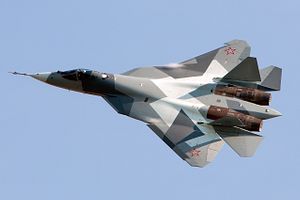The Russian Air Force will likely receive two additional fifth-generation T-50 (PAK FA) multi-role fighters in 2017, Russia’s Deputy Defense Minister Yuri Borisov said earlier this week. That will bring the total of T-50 prototypes currently undergoing extensive testing by the service to 11.
“The work on PAK FA is now at the final stage, and this year we receive the 10th and the 11th planes, which will be tested, and in the future state armament program for 2018-2025 we plan [the] first purchases of T-50 fighters,” Borisov said on June 5, according to TASS news agency.
The Sukhoi T-50 (PAK FA) — the name will change for the production aircraft — is a fifth-generation multirole, single seat, twin-engine air superiority/deep air support fighter currently under development. It is intended to replace the Russian Air Force’s fleet of MiG-29 and Su-27. Once operational, it will be the first stealth fighter jet to be inducted into the Russian Air Force.
While several hundred test flights have occurred this year and last, the main technical obstacle to overcome is designing and producing a new engine for the aircraft.
“The fifth-generation engines still do not exist, and the PAK FA still flies on modified engines from the Su-27, Su-30, and other aircraft from that series,” according to a Russian aviation expert.
The (PAK-FA) T-50 prototypes are for now equipped with a derivative of the Saturn AL-41F1S engine, dubbed AL-41F1. The engines are also installed on the Sukhoi Su-35S Flanker-E.
The new engine currently under development — the next-generation Saturn izdeliye 30 — is expected to be ready by 2020. It will feature increased thrust and fuel efficiency
“I think it will have speeds of 1.6 Mach [about 1,200 miles per hour], depending on the location over which the flight takes place,” according to the Russian aviation expert. “The engine will also improve the PAK FA’s stealth capacity thanks to new composite materials.”
The PAK-FA/T-50 fighter jet will be armed with beyond visual range air-to-air missiles and different variants of air-to-ground missiles inside the aircraft’s two main internal weapon bays (two additional triangular-section weapon bays are located under the fuselage).
The aircraft could also be fitted with the nuclear-capable BrahMos-A supersonic cruise missile.
As I reported last month, the fighter jet will also be armed with an extended range Kh-35UE tactical cruise missile.
“Nicknamed ‘Harpoonski’ [Kharpunskiy] due to its similarity to the U.S.-made Harpoon anti-ship missile, the Kh-35UE is a subsonic, sea-skimming anti-ship cruise missile armed with a 145 High Explosive (HE) fragmentation, penetration warhead,” I explained.
Both the BrahMos-A and KH-35UE do not fit into the aircraft’s internal weapon bay and consequently will need to be carried under the aircraft’s wings in a transport launch canister, which will reduce the fighter jet’s stealthiness.































